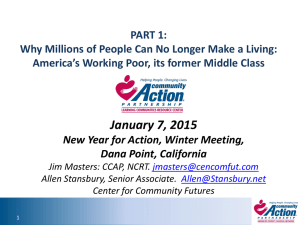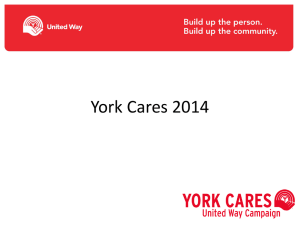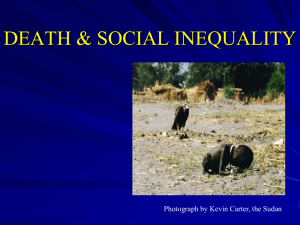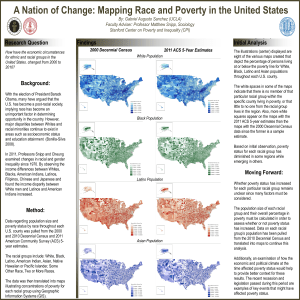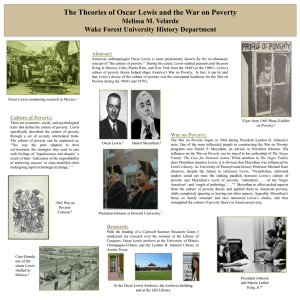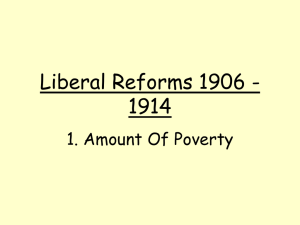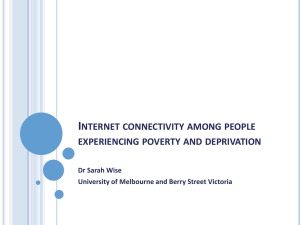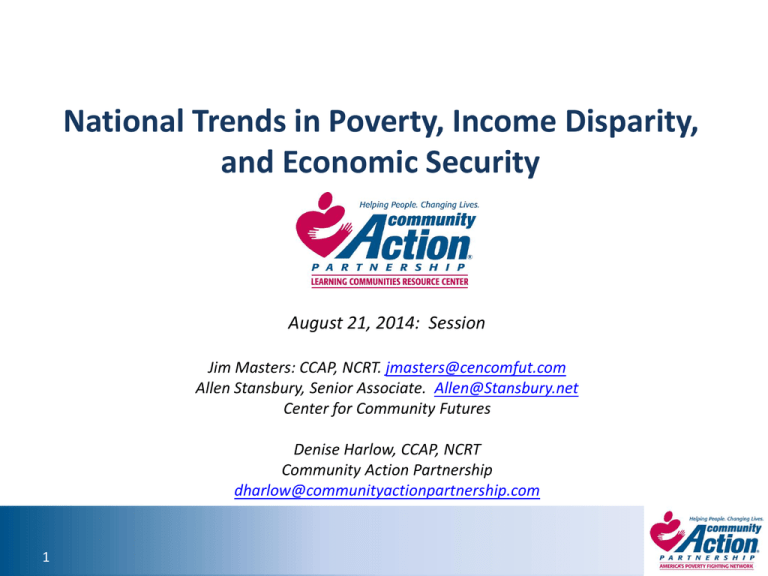
National Trends in Poverty, Income Disparity,
and Economic Security
August 21, 2014: Session
Jim Masters: CCAP, NCRT. jmasters@cencomfut.com
Allen Stansbury, Senior Associate. Allen@Stansbury.net
Center for Community Futures
Denise Harlow, CCAP, NCRT
Community Action Partnership
dharlow@communityactionpartnership.com
1 1
Agenda
•
•
•
•
Welcome and Introductions
Technology Overview
Learning Communities Resource Center Overview
Key themes for the National Trends Learning
Cluster
• Reading Discussion
• Next Set of Assignments
• Meeting Schedule
2
2
The Learning Communities Resource Center
• Funded by OCS-2 year project
• The full project is the “Learning Community”
• 5 Primary Learning Clusters
–
–
–
–
–
Decreasing Family Homelessness
Increasing Financial Empowerment for Families
Increasing Organizational Capacity (Board Governance)
Utilizing Place-Based Strategies
Bundling Services to Improve Outcomes
• 3 Specialty Learning Clusters
– National Trends in Poverty
– Standards Implementation for States-Links with OSCOE
– Tracking CSBG Dollars-Links with ROMA Next Generation
3
3
Information Will Be Posted on the
Partnership’s Website
www.communityactionpartnership.com
4
4
Learning Cluster on National Trends
Major shapers of a society
1. Demographics (30%)
2. Economics (including science, technology
and trade) (30%)
3. Social values (Alexis de Tocqueville) (20%)
4. These interact – in odd combinations -- to
shape public policy. (5%)
5
5
Session 9 Topic Areas:
• Changing Demographics of Poverty today in the US
• US Economy 1947-2010 A Perspective by Robert
Reich, UC Berkeley Professor of Political Policy
• Poverty’s Transformation in America: America’s
New Working Poor, its former Middle Class
• The stagnation or decline of wages and salaries
• Income Inequality: Household Income and Assets
Accumulation Trends to Higher Income Brackets
• Poverty is now Mainstream: The Decline of Upward
Mobility
6
6
Session 10 Topic Areas:
Seeking a New Approach
•
•
•
•
7
America’s Frayed Safety-Net
Strategies for a solution to curb
growing poverty in the US
Draft White Paper Discussion
Nation-wide Survey Questionnaire
7
Changing Demographics of
Poverty Today in the US
US DEMOGRAPHIC TRENDS
8
US Demographic Megatrend Highlights
MACRO TRENDS:
1. US population growth rate: rate of increase has declined to less
than 1% per year up from a high of 1.8% in the early 60’s.
2. Life expectancy: a graying nation but expectancy varies greatly
3. Urban vs rural: continued migration from rural to urban
communities
4. The US Family make-up: on an evolutionary path
TRENDS SHAPING POVERTY:
1. Households: growing single head of households and/or shared
households
2. US Birth rate: steadily declining, but more unwed mothers
3. More children in poverty in the last 20 years
4. Diversity and immigration: Adds up to greater national strength
but little upward mobility for minorities
9
9
US Population 1950-2010
Population doubled from 1950 census of 152 million to 308.7 million in 2010.
Declining growth rate from 1.8% to less than 1% as shown in the red line below.
10
Declining US Birth
Rate
• US births reached an all-time
high of more than 4.3 million in
2007 dip to 3.9 million.
• First-time mothers later in life:
average age of first-time
mothers rose from 21.4 years
in 1970 to 25.0 years in 2006.
First birth rates aged 40–44
stable during the 1970s and
early 1980s, but increased
more than four-fold from 1985
through 2012 (from 0.5 to 2.3).
• Significant declines in teen
childbearing that began after
1991 have strengthened in
recent years.
11
Increasing Life Expectancy
1. US Population is aging regardless
of gender or ethnicity is at 78.5
up from an 1965 estimated 70.2.
But it stands 20th of 34
developed nations
2. Life expectancy varies by
ethnicity - life expectancy for all
American’s in 2013
Males (76.0) and females
(80.9) and
Whites (78.8),
Black (74.5),
Hispanic (81.2).
1965 estimates black males
lived on average to 61 and
females to age 66.6
12
Life Expectancy, Education and Ethnicity
• In 2008 white males with 16+ years of education live 14.2 years longer than black
men with less than 12 yrs of education, for women difference is 10.3 yrs.
• Trends in disparities at the educational extremes are widening. In 1990 the most
educated men and women lived 13.4 years and 7.7 years longer, respectively,
than the least educated.
• Differences in life expectancy at birth between the most and least educated,
within race/sex groups, in 1990 the gap in life expectancy between the most and
least educated white females was 1.9 years; now it’s 10.4 years, see chart below.
13
13
Accelerating American Retirement Rate
10,000
On January 1, 2011
“roughly 10,000
Baby Boomers will
turn 65 and about
10,000 more will
cross that
threshold every
day for the next 19
yrs.”
Pew Research
Center
Dec. 29, 2010
14
• Baby boomer generation (born 1945-50) of 77
million began retiring mid 2000’s. US Census
figures for 2010 showed that 13% of the US
population is 65 or older. Projections indicate
that in 20 years it will be 19.3%
• Current economic conditions is causing
retirement to be postponed; but, in some
instances where unemployment is very high,
causing early retirement.
• 58% of the US workforce do not participate in
a retirement plan be it employer sponsored or
through savings in a 401 k program..
• However, well-educated people increasingly
work longer than the less-skilled
14
Aging population = Aging Workforce
•
By 2022 31.9% of those ages 65 to 74 will still be working. That compares with 20.4% of the same age
bracket in the workforce in 2002 and 26.8% who were in the workforce in 2012 (see graphic below)
Cutback in pensions during the last 10 years, almost 20% of Americans aged over 65 are now in the
labor force, compared with 13% in 2000.
The aging of the baby boom increases the proportion in the older age groups, but may be offset by
projected immigration into the working age groups.
•
•
15
15
US Households Trends:
More Single Heads of Households
Growing Number of Single Mom and Dad Head of Households
•
•
•
•
•
•
16
In 2010 the householder, his or her spouse, and
his or her sons and daughters comprised 262.0
million people or 87 % of the population.
Of the 88.8 million children of householders, 93
% were biological children.
“Husband-wife households numbered 56.5
million in 2010 and made up 73 % of all family
households in 2010.
Family households maintained by a female
householder with no spouse present numbered
15.3 million, more than twice the number
maintained by a male householder with no
spouse present (5.8 million).
Among nonfamily households, one-person
households predominated (31.2 million) and
were more than three times as common as
nonfamily households with two or more people
(8.0 million).
More women than men lived alone (17.2 million
and 13.9 million, respectively).
Growing Ethnic Diversity
America is becoming a majority minority
nation
•
In 2010 while 80% of American seniors are
white, the U.S. population is projected in 2050 to
be even.
In the last census the Hispanic population grew
by 2.2 %, or more than 1.1 million, the most of
any group, with 76 % resulting from natural
increase.
Asians were the fastest-growing major ethnic or
racial group growing by 2.9 %, or 530,000, with
immigration from overseas accounting for 60 %
of that growth.
Blacks increased by 559,000, or 1.3 %.
Shift in birth and death rates on non-Hispanic
whites in part to the recent global recession, and
that “the growing number of older non-Hispanic
whites, will accelerate rapidly as the baby boom
ages, guarantees that non-Hispanic white natural
decrease will be a significant part of the nation’s
demographic future and in turn offers a young
new workforce.
•
•
•
•
17
A Nation of Immigrants
•
1970 the percentage of foreign born in the US was
5-6%, 2010 US Census showed that number to be
nearly 13 % or nearly 40 million
Foreign-born women had a higher fertility rate
than native women.
62 % of the foreign born came to live in the
United States in 1990 or later, including 35 % who
entered in 2000 or later.
Of all foreign born who arrived before 1980, 80 %
were U.S. citizens in 2010. 63% of the foreign born
who arrived between 1980 and 1989 were
naturalized citizens.
As of 2010, 44 % of all foreign born were
naturalized citizens.
Foreign born households were 77% compared to
65% of the native population.
The average size of foreign born households (3.4
persons) was larger than that of native
households (2.5 persons). One reason for this
difference is that a higher proportion of foreignborn family households (62 %) than native-born
family households (47 %) included children under
the age of 18.
•
•
•
•
•
•
18
Racial / Ethnic Makeup of U.S. Poor
Population, 1973 and 2010
• Latinos represent a much larger
part of the poverty picture today
than four decades ago.
• 1973: 56 percent of poor
Americans were white, 32 percent
were black, and 10 percent were
Hispanic
• 2010: 42 percent of the poor are
white, 23 percent are black, and
29 percent are Hispanic.
• Hispanics have overtaken poor
blacks in number, members of
these two groups were about
equally likely to be poor in 2010
(27 percent), much more so than
whites (10 percent).
Source: U.S. Census Bureau, Current Population Survey Annual Social and Economic Supplements
19
Share of U.S. Poor Populations by
Community / Metro Type, 1970–2010
•
The poverty rate of suburbia was
higher in 2010 (11.4 percent) than in
1970 (8.7 percent),
City’s poverty rates grew by an even
greater margin (20.9 percent in 2010
versus 14.7 percent in 1970).
Mostly concentrated - about four in five
residents of extremely poor major
metropolitan neighborhoods live in
cities.
Nonetheless, growing shares of the
suburban poor reside in communities
of moderate to high poverty, where at
least 20 or 30 percent of individuals live
below the poverty line
•
•
•
20
Source: Re-Emergence of Concentrated Poverty: Metropolitan Trends in the 2000s, Brookings Institute 11-3-11
Child Poverty in the US
US Census figures released in September 2013 showed that record-high numbers of Americans are living in
poverty. The latest data reveal:
•
One out of seven people in the USA are living in poverty.
– In 2012, 46.5 million people were living in poverty in the United States—the largest number in
the 54 years the Census has measured poverty.
– The poverty rate (the percentage of all people in the United States who were poor) also
remained at high levels: 15% for all Americans and 21.8% for children under age 18.
•
Almost one out of sixteen people in the USA are living in deep poverty.
– People with income 50% below the poverty line are commonly referred to as living
in deep poverty; Census figures show that, in 2012, 6.6% of our population, or 20.4 million
people, were living in deep poverty.
•
Children represent more than one-third of the people living in poverty and deep poverty.
– In 2012, 73.7 million American children represented 23.7% of the total U.S. population, but
made up 34.6% of Americans in poverty and a full 35% of Americans living in deep poverty.
– Overall, 21.8% of children under 18—or some 16.1 million American youth—were living below
the poverty line. Though the poverty rate of 9.1% for Americans aged 65 and older remained
steady since 2011, the number of older Americans in poverty increased from 3.6 million to 3.9
million. For citizens aged 18 to 64, 13.7%—26.
•
According to Annie E. Casey Foundation research showed that 23% of children in 2012 are
living in families below the poverty line.
– 5 million—lived in poverty.
21
21
Child Poverty In America
Ages 5-17 from 2007-2012
US Census map showing percentage-point change in poverty rates among children
•
Among the counties with school-age child poverty rates significantly higher than the national
average of 21.1 percent in 2012, 75 percent were in the South. In 2012, there were 13,544
school districts.
Of these, 14.7 % had poverty rates greater than 30 percent, for the population of school-age
children in families.
The five lowest states are Arizona, Louisiana, Nevada, New Mexico and Mississippi, and the top
five states are Massachusetts, Vermont, Iowa, New Hampshire and Minnesota.
•
•
Map Source: http://www.washingtonpost.com/blogs/govbeat/wp/2013/12/17/the-49-states-of-rising-child-poverty/?wprss=rss_national
22
America’s Evolving Family Makeup
Selected trends impacting America’s Family Makeup:
•
Median age at first marriage was28.2 for men and
26.1 for women in 2010, an increase from 26.8 and
25.1 in 2000. An continued increase of a long-term
trend since the mid-1950s.
•
Overall percentage of adults who were married
declined to 54.1 % in 2010 from 57.3 % in 2000.
•
The average household size declined to 2.59 in 2010,
from 2.62 people in 2000 partly because of the
increase in one-person households, which rose from
25 % in 2000 to 27 % in 2010, more than double the
13 % in 1960.
•
Households headed by a married couple who had
children under 18 living with them declined 3 % in
2010, from 24 % in 2000.
•
“Breadwinner moms,” mothers who are the only or
main provider of income for their family rose from 11
percent to 40 percent from 1960 to 2011 (see chart
to left).
•
Americans living alone was a mere 9% in 1950 is now
28% today.
•
Children living together with both their parents have
been steadily declining since the 1970’s
•
2011 two parent families comprised on about 67%
down from about 92% in 1960.
23
AMERICA’S SOCIAL VALUES
24
Inglehart Values Map
The global cultural map shows how scores of societies are located on these two dimensions
Tradition
al values
vs
Secularrational
values
Survival values vs Self-expression values
25
25
America’s Perceptions of Demographic Trends
Source: The Public Renders a Split Verdict On Changes in Family Structure, PEW Research Feb. 16, 2011
26
A Perspective by Robert Reich,
UC Berkeley Professor of
Political Policy
US ECONOMIC TRENDS 1947-2013
27
US Economic Trends 1947-2013
Great Prosperity (1947 and 1979)
• The nation as a whole grew faster and
median wages surged
• Creating a growing middle class
• Consuming more goods and services,
• Creating more and better jobs
VS Great Regression (1980-2009)
Productivity continued to grow, economy
continued to expand, wages flatten due to:
• New technologies,
• Global competition,
But most important
• Government policies favoring business and
investors
(Chart Source: Robert Reich, the Limping Middle Class, NY
Times)
28
Income Gains 1947 to 1979 vs
Income losses 1980-2009
• 1947-1979 Government
policies benefiting
growing middle class
• 1980 to now Government
policies changes
benefiting business and
investors
– Business regulations,
– taxes and
– fiscal policies
29
Wealth Trends in the US 1913-2009
1918 and 1933, 1981 to now:
• Greater concentration of
wealth, while
• Slow growth slowed
• Median wages stagnated
and
• Then 2 major downturns
(1929-32, 2007-2009)
It’s no mere coincidence that
over the last century the top
earners’ share of the nation’s
total income peaked in 1928
and 2007 — the two years just
preceding the biggest
downturns.
30
Growth of Debt and Women in the
Workforce 1947-2009
Women in the work force grew:
• 1960s 12 % of married
women with young children
• Late 1990s, 55 % women in
the workforce
Meanwhile Americans went
deeper into debt:
• From the late 1990s to 2007,
the typical household debt
grew by a third.
31
America’s New Working Poor,
its former Middle Class
THE TRANSFORMATION OF
POVERTY IN AMERICA
32
Unemployment Rate and Median
Household Income Index 2000-2013
33
33
Trends in Real Income 1929-2012
34
Source: Saez and Piketty, UC Berkeley, The Economist (9-2013)
34
America’s New Working Poor
• Systematic productivity gains going to the
investor and corporate executives not to wage
and salary workers
• Resulting in 20-30 years of wage/salary
stagnation
• Accelerated in the “2001 Bush Tax Cuts”
capping the capital gains tax at 15%
35
35
How US Wages and salaries stagnated or decline 1980-2014
36
Source: Center for Community Futures 8-6-14
36
The stagnation or decline of
wages and salaries
WAGE & SALARY TRENDS IN THE US
37
Wages & Salaries: Production Out-pacing Wage Trends
•
American Workers have been experiencing wage
rate declines and stagnation for some time
Between 2000 and 2007, the last full business
cycle before the start of the Great Recession,
productivity grew 16.0 %.
But, compensation grew by just 9.4 %
Wage and compensation growth in the first few
years of this period was buoyed the strong wage
and compensation growth of the late 1990s.
Accompanying Figure A shows year-by-year
productivity growth along with compensation
growth as measured by the ECI and the ECEC
since 2000. It shows that there has been no
sustained growth in average compensation since
2004.
The weak wage and compensation growth in the
2000–2007 business cycle, combined with the
even weaker growth in the Great Recession and
its aftermath, mean that average wage and
compensation growth was far outpaced by
productivity growth
The stagnation began even earlier, in 2003, when
considering wages alone.
•
•
•
•
•
•
38
Source: A DECADE OF FLAT WAGES The Key Barrier to Shared Prosperity and a Rising Middle Class,
Economic Policy Institute, Lawrence Mishel and Heidi Shierholz, August 21, 2013
Middle Income Earners trending toward the Working Poor
• These long-term unemployed are
not just unskilled labor but well
educated middle class wage and
salary earners
• Until the great recession of 20072009 many were employed their
entire life.
• Only 11 % of those who were longterm unemployed in a given
month returned to steady, fulltime employment a year later
• Half of the long-term unemployed
are non-Hispanic whites.
• In other words these were the
middle class who are now
America’s new working poor.
39
Wages and Salaries: Wage growth trends
• In 1964 SSI national wage
index* was $4,576.32
• 2012 it stood at $44,321.67,
nearly a 1,000% increase
• 1992 the raw average wage
was $22,002 and the median
$15,610, nearly 71%.
• 20 years later ratio declined
to 64.75%
Meaning that those below the
media (50%) are earning lower
wages while the average wage
earner is earning higher wages
*National wage index is based on compensation (wages, tips, and
the like) subject to Federal income taxes, as reported by employers
on Form W-2
40
America’s Workforce Trends:
Decline of middle income jobs
•
CEPR the share of good jobs declined
overall between 1979 and 2010, however
while males were the majority of the jobs
lost, there was a steady increase in
female employment.
Meanwhile the workforce aged during
this same time period
40% of those good jobs requiring a
degree held steady at about 42-45%
while those with only a high school
degree fell sharply from about 17% to
about 5% during the period of 1979-2010
Share of good jobs (one that pays at least
$18.50) an hour declined overall between
1979 and 2010,
Males were the majority of the jobs lost,
there was a steady increase in female
employment.
•
•
•
•
41
Household Income and Assets
Accumulation Trends to
Higher Income Brackets
INCOME INEQUALITY
42
Income Inequality Increasing
• Household income follows a long period in
which income concentration remained relatively
flat.
• Economists Thomas Piketty and Emmanuel Saez
using U.S. tax returns found that income
concentration dropped dramatically following
both World Wars and was roughly unchanged
for 20yrs.
• It started climbing again in 1975, reaching preWorld War I levels by 2000
• U.S. income inequality has now reached levels
not seen since 1928 (Saez).
• In both cases, a similar pattern was in evidence-a boom in the financial sector, over-leveraged
lower-income households, a massive, systemic
financial crash--and the two worst economic
slumps in U.S. history, the Great Depression and
Great Recession, followed.
• A 2011 CBO report shows that real net average
U.S. household income grew 62% from 19792007, household income growth was much more
rapid at the higher end of the income scale than
at the middle and lower end.
• A CBO 2013 follow-up report showed that aftertax average income soared 15.1% for the top 1%
from 2009 to 2010, but grew by less than 1% for
the bottom 90% over the same time period, and
fell for many income groups.
• Census Bureau estimates that real mean
household income increased 0.2% in 2011 and
2012, but it declined for all groups other than
those in the top fifth of earners.
Source: S&P August 4, 2014 Economic Report: How Increasing Income Inequality Is Dampening U.S. Economic Growth
43
43
Household Wealth Trends 2004-2010 by Income
Source: S&P August 4, 2014 Economic Report: How Increasing Income Inequality Is Dampening U.S. Economic Growth
44
44
Economists Agree: Income Inequality Increasing
•
Robert Reich, Professor of Public Policy at U.S. Berkeley, argues that increased inequality has reduced overall
aggregate demand noting that high-income households have a lower marginal propensity to consume (MPC) out
of income than other households, and they're currently holding a bigger slice of the economic pie.
Economists Atif Mian, Kamalesh Rao, and Amir Sufi confirm this, finding the MPC for households with an average
annual income of less than $35,000 to be three times larger than households with average income over $200,000.
Mian and Sufi also found that, as home values increased between 2002 and 2006, low-income households very
aggressively borrowed and spent - while high-income households were less responsive.
When housing wealth declined, spending cuts for low-income households was twice as large as that for rich ones.
Mian and Sufi further used ZIP codes to locate areas with disproportionately large numbers of subprime
borrowers (those with low incomes and credit ratings) and found that these ZIP codes experienced growth in
borrowing between 2002 and 2005 that was more than twice as high as in ZIP codes with wealthy "prime"
borrowers.
After 2006, the subprime ZIP codes experienced an increase in default rates three times that of prime ZIP codes.
Raghuram Rajan claims that, while high-income individuals saved, low-income individuals borrowed beyond their
means in order to sustain their consumption, and that this overleveraging, as a result of increased inequality, was
a significant cause of the financial crisis in 2008.
An IMF paper by Michael Kumhof and Romain Ranciere confirms Rajan linking income distribution and financial
excess suggests that these same factors were likely at play in both the Great Depression and Great Recession.
Unfortunately, coming back from the Great Recession appears to be taking longer than many had hoped. With a
post-recession annual growth rate of 2.2%, our recovery is not even half the historical average annual growth of
4.6% for other recoveries going back to 1959. This is not a complete surprise, given that financial crises are often
followed by prolonged recessions and a long bout of subpar growth--thanks in part to the deleveraging that
comes as people try to repair their finances.
•
•
•
•
•
•
•
•
Source: S&P August 4, 2014 Economic Report: How Increasing Income Inequality Is Dampening U.S. Economic Growth
45
45
Today:
The Post Global Recession
THE WEAK RECOVERY
2009-2014
46
Headwinds Holding Back the US
Economy
1. An anemic housing market,
2. Continuing cuts in federal government spending,
and
3. Weaker global growth that reduced demand for
American exports.
4. The slowing growth in the size of the American
labor force,
– Due to demographic factors like the retirement of
baby boomers and
– Workers who have given up looking for jobs i.e.
unusable skill sets
"The Great Recession--Moving Ahead,“ Federal Reserve Vice Chairman Stanley Fischer
47
47
Lost Jobs, Missing Workers, Stagnant Wages
As of June 2014 the weak recovery from the recession:
•
•
•
Number of jobs reached the previous peak of
January 2008,
– Gains of more than 8.5 million jobs since early
2010.
– However, the working-age population has
grown substantially in the last six years, and
– Reliable estimates is at least seven million jobs
below its potential
– Costing hundreds of billions of dollars in lost
output.
More than four million people are still considered
among the long-term unemployed,
– Out of work for at least half a year.
– Considerably dimmer prospects of finding
another job as their skills deteriorate and their
contact with the world of work fades.
And that does not count the more than six million
who have opted out of the labor force altogether,
even taking into account demographic factors like
the aging of the population.
Source: NY Times “The Nation’s Economy, This Side of the Recession” 6-14-14
48
For Many Americans, Not Much of a Recovery
• The richest Americans have generally recouped
their losses from the recession and gained
considerable new wealth during the recovery,
• The current situation is worse for the poor and
for low-wage workers than it was in 2007,
• Jobs dried up and wages stagnated, tens of
millions of Americans took jobs with lower pay
and fewer hours,
• Many turned to the federal government for
additional support to help make ends meet.
• The number of people receiving food stamps
under the Supplemental Nutrition Assistance
Program soared to 47.6 million in 2013 from
26.3 million in 2007.
• Incomes for the typical middle-income family
have slipped,
• The nation’s poverty rate remains above its
prerecession level.
49
2007-09 Recession Recovery
#1 reason for lack of job creation
4.18 Trillion currently in Cash
Deposits and growing
• $2.58 Trillion sitting in US
Banks (see FRED chart)
– Huge deposits began in 2009
– Before it was never more than
$1 to $1.5 billion
• $1.6 Trillion corporate
deposits in off-shore banks
– Mostly to avoid US corporate
taxes or
– Acquisitions of start-ups and
competitors
50
Source: Federal Reserve Economic Data – St. Louis
THE UPSHOT|How the Recession Reshaped the
Economy, in 255 Charts (NY Times 8-6-14)
http://www.nytimes.com/interactive/2014/06/05/upshot/how-the-recession-reshaped-the-economy-in-255-charts.html?ref=economy
51
51
The Decline of Upward
Mobility
POVERTY IS NOW MAINSTREAM
52
Poverty and the US Economy
• Poverty rates decline from
its high in 1959, on the
upswing since 2005
• In 1969 the official
government rate was
13.7%.
• In 1989 it was at 13.1%
• In 2009 with the slide of the
middle class into poverty
the rate was at 15%
• 2011 the poverty rate for
women in 2011 was 16.9%
and for children over 20%.
53
Poverty has become mainstream
•
•
•
•
54
Nearly 40 % of Americans between the
ages of 25 and 60 will experience at
least one year below the official poverty
line during that period ($23,492 for a
family of four)
54 % will spend a year in poverty or
near poverty (below 150 %of the
poverty line).
If related conditions like welfare use,
near-poverty and unemployment were
added, four out of five Americans will
encounter one or more of these events.
Half of all American children will at
some point during their childhood
reside in a household that uses food
stamps for a period of time.
Source: Wall Street Journal
Declining Upward Mobility
•
What was once thought that over
80% of sons of fathers born in the US
moved up the ladder, now it is far
less, now 34% believe this.
65 % born in the bottom fifth stay in
the bottom two-fifths.
•
– Once it was thought that 20% of success
was based upon family inheritance
being passed from one generation to
the next.
– Today studies have found that it is the
other way around, inheritance is the
basis for success
•
There is greater opportunity for
upward mobility in many other
countries
– Educational and wage and mobility is
greater in Denmark, Australia, Norway,
Finland, Canada, Sweden and Germany
Source: Oxfam Survey - Perception of Economic Mobility
55
Upward mobility in the 50 largest metro areas
comparing the top 10 and the bottom 10 areas
Odds of Reaching Top 5th
Rank
Location
Odds of Reaching Top 5th
Rank
Location
Starting from Bottom Fifth
Starting from Bottom Fifth
1
San Jose, CA
12.90%
41
Cleveland, OH
5.10%
2
San Francisco, CA
12.20%
42
St. Louis, MO
5.10%
3
Washington DC, DC
11.00%
43
Raleigh, NC
5.00%
4
Seattle, WA
10.90%
44
Jacksonville, FL
4.90%
5
Salt Lake City, UT
10.80%
45
Columbus, OH
4.90%
6
New York, NY
10.50%
46
Indianapolis, IN
4.90%
7
Boston, MA
10.50%
47
Dayton, OH
4.90%
8
San Diego, CA
10.40%
48
Atlanta, GA
4.50%
9
Newark, NJ
10.20%
49
Milwaukee, WI
4.50%
10
Manchester, NH
10.00%
50
Charlotte, NC
4.40%
Source: NBER-Where Is The Land Of Opportunity? The Geography Of Intergenerational Mobility In The United States
56
56
SESSION 10:
SEEKING A NEW APPROACH
• America’s Frayed Safety-Net
• Strategies for a solution to
curb growing poverty in the US
• Draft White Paper Discussion
• Nation-wide Survey
Questionnaire
57
America’s Frayed Safety-Net
• SNAP: November 2013, food benefits were cut for approximately
48 million Americans by an average of 7 percent, costing the typical
recipient about $9 a month.
• Unemployment Benefits: January 2014, 1.3 million jobless workers
stop receiving an unemployment check, after Congress’s refusal to
prolong the extension of emergency jobless benefits to up to 73
weeks, from 26. Perhaps as many as five million people will lose
their benefit over the next year.
• Affordable Care Act. Despite its success of registering a significant
number who did not have health care insurance in 2013, states and
members of congress war against the program continues unabated.
As of May 2014 24 states had not extended health care coverage in
their states.
• Temporary Assistance for Needy Families (TANF) Despite a decline
of 60% in its case load since 1998, it is positioned as a disincentive
to finding work.
58
58
America’s Declining Safety Net
59
Monthly Participation in the SNAP
food stamp program 1990-2012 actual
and 2012-2020 projected
60
60
Selected Anti-Poverty Strategies
• Center for American Progress: “Half in Ten”
Campaign
• Economic Policy Institute
• New American Foundation
• Ryan’s Alternative Anti-poverty Strategy
61
61
“Half in Ten” Campaign
Success Stories:
• Child Care
• Food and Nutrition
• Education
• Health
• Housing
• Income Assistance
• Jobs training
• Low-income tax credits
• WIC
• Unemployment Insurance
• Minimum wage
62
Call to Action July 21, 2014 Re:
New House Child Tax Credit Bill Leaves
Behind Millions of Low-Income Working
Families
•
While it permanently extends the Child Tax Credit
higher up the income scale so more families with sixfigure incomes will benefit.
•
It fails to make permanent the 2009 reduction
in the CTC’s earnings threshold, set to expire
at the end of 2017.
If this provision expires, a single mother with
two children who works full time throughout
the year at the minimum wage and earns
$14,500 would lose her full CTC of $1,725 in
2018.
•
•
It indexes the current maximum credit of $1,000
per child to inflation. This provision would not
help most working families with low or moderate
incomes, because it benefits only those with
incomes high enough to receive the maximum
credit.
Economic Policy Institute (www.EPI.org)
Issues Focus:
• Labor Laws – Examples
– Extend Unemployment Benefits - State Cuts to Jobless
Benefits
– Tipped Workers and Minimum Wage
• Tax Credits –Examples
– The Earned Income Tax Credit
– Child Tax Credit
• Immigration reform - Example
– Overloaded Immigration Courts
63
63
New American Foundation
Asset Building Program: issues and papers
•
•
•
•
•
Children's Savings Accounts
Solving the Retirement Puzzle
Rebalancing the Scales
The Financial Health Check
Connecting Tax Time to Financial Security
California Civic Innovation Project technology to influence local government
•
“Public Pathways: A Guide to Online Engagement Tools for Local Governments
Economic Growth Program research papers such as:
•
•
•
The Wizard of Jobs a US labor status report on the first 6 months of 2014 and its continued
jobs slump.
America's Debt Problem discusses the impact on middle and low income classes due to
excessive private debt and its consequences.
Pay More, Get Less that takes a look at the cost of health, medical, education, basic financial
services and communications
64
64
Tax Reform Strategies
• Background
• Simplification and Tax Reform Measures
• Reform of the Tax Expenditure System
65
65
Tax Reform - Background
• Last overhauled of the federal tax code: 1986
• Tax Cuts, i.e. lowering of capital gains to 15% have
benefited the wealthy, however
• Middle and Low Income have been hit by increased
“payroll” taxes
• Tax reform is the best way to tackle “income
inequality”
• One tax reform strategy: raising taxes on high-income
earners and corporations to pay for expanded
benefits to low-income Americans.
• Second alternative: classic tax reform of “broaden the
base, lower the rates.”
66
66
Tax Reform and Simplification
Three recommendations for reform and
simplification:
• National Commission on Fiscal Responsibility and
Reform Simpson-Bowles 6 Part Budget Plan
• Urban and Brookings Institute Tax Policy Center
• US Senate Committee on Finance Tax Reform List
• Reform of The Distribution of Major Tax
Expenditures in the Individual Income Tax System
67
67
Please visit our Blog Site:
Decline of the US Middle Class,
America’s New Working Poor
http://declineofusmiddleclass.blogspot.com/?view=sidebar
6868
Learning Communities Resource
Center Contacts
• Barbara Ledyard – Project Director, Learning Communities Resource Center
bledyard@communityactionpartnership.com, 202-449-9775
• Denise Harlow – Senior Director, Training and Technical Assistance
dharlow@communityactionpartnership.com, 202-595-0660
• Sonji Dawson Johnson – Program Specialist
sjohnson@communityactionpartnership.com, 202-769-5524
• Cashin Yiu – Program and Event Coordinator
cyiu@communityactionpartnership.com, 202-683-9090
This publication was created by the National Association of Community Action Agencies – Community Action Partnership, in the performance of the U.S. Department of Health
and Human Services, Administration for Children and Families, Office of Community Services Grant Number 90ET0436. Any opinion, findings, and conclusions, or
recommendations expressed in this material are those of the author(s) and do not necessarily reflect the views of the U.S. Department of Health and Human Services,
Administration for Children and Families.
69
69

